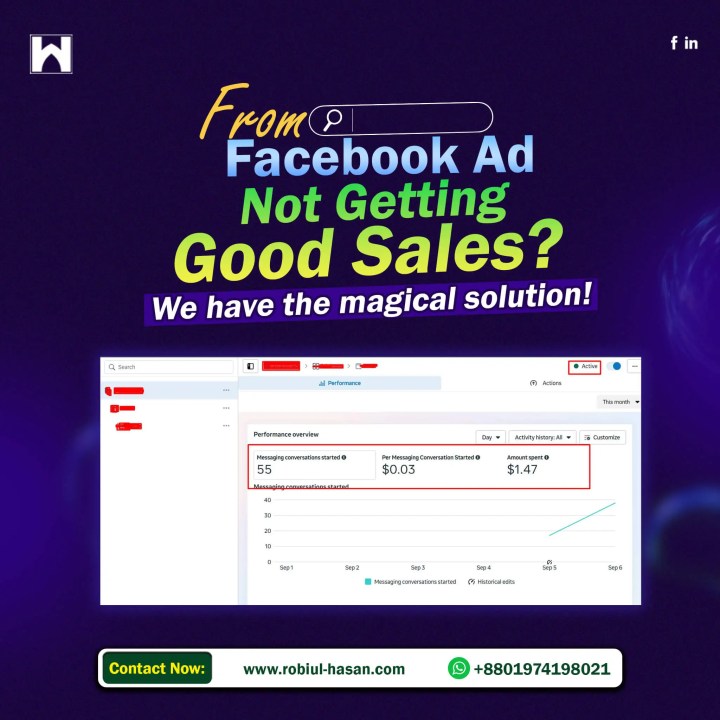Facebook ads have become the backbone of modern digital marketing, offering businesses a direct way to connect with billions of active users. With precise targeting options, creative flexibility, and scalable budgets, Facebook has positioned itself as one of the most powerful platforms to generate sales. Yet, despite these opportunities, many business owners and marketers find themselves scratching their heads, wondering why their Facebook ads are not converting into actual sales. Why Your Facebook Ads Aren’t Converting into Sales.
The truth is, running ads on Facebook isn’t as simple as pressing a few buttons and waiting for profits to roll in. Successful ad campaigns require strategy, testing, creativity, and a deep understanding of how the platform works. Otherwise, your hard-earned money can disappear with little to no return.

If you’ve been pouring money into Facebook ads only to see disappointing sales, don’t worry you’re not alone. The majority of advertisers face this challenge at some point. But the good news is, there is a solution. With the right approach, your ads can go from being money draining experiments to revenue-generating machines. In this article, we’ll dive deep into the reasons why Facebook ads often fail and reveal the “magical solution” to turn your campaigns around for maximum profitability.
Why Facebook Ads Fail to Generate Sales
It’s frustrating to spend hours setting up a campaign only to watch your results trickle in with little to no sales. But understanding why Facebook ads fail is the first step toward fixing them.
Poor Targeting Strategies
One of the most common reasons ads don’t bring in sales is poor audience targeting. If you’re showing your ads to the wrong people, even the most eye-catching creative won’t convert. Many businesses fall into the trap of targeting too broad an audience or guessing who their buyers are without using real data.
For example, if you’re selling premium fitness equipment, showing your ad to a broad audience of “peopleinterested in fitness” isn’t enough. You’ll likely reach people who prefer budget equipment or those who are simply curious about fitness but have no real intent to buy. Precision targeting using Facebook’s detailed demographic and behavioral filters is key to finding the right buyers.
Weak Ad Creatives and Messaging
Your creative is the first thing people notice in an ad. If it doesn’t grab attention within the first three seconds, you’ve lost the battle. Ads with generic stock photos or bland copy rarely inspire action. People scrolling through their feed need a reason to stop, read, and engage with your offer.
A successful Facebook ad speaks directly to the pain points and desires of its audience. For example, instead of saying “Buy our shoes,” a stronger message would be “Say goodbye to sore feet—experience all-day comfort with our premium sneakers.” That kind of copy makes the ad relatable and benefit-driven.

Budget Mismanagement
Another major factor is how businesses allocate their budgets. Some spend too little, expecting big results overnight, while others waste thousands of dollars without a clear strategy. Running ads without testing and optimization often leads to wasted spending.
Facebook ads thrive when campaigns are managed strategically starting small, analyzing data, and scaling up gradually. Without proper budget allocation, you either risk underexposure (where not enough people see your ads) or overspending (where you pay more for clicks that don’t convert).
Lack of Testing and Optimization
Finally, many advertisers set up an ad, let it run, and hope for the best. This “set it and forget it” approach rarely works on Facebook. Successful campaigns require ongoing testing different creatives, audiences, placements, and bidding strategies. Without testing, you won’t know what’s working or what’s wasting money.
The solution lies in treating Facebook ads as a science experiment constantly testing, analyzing, and refining until you find the winning formula.
Understanding Facebook’s Algorithm
Facebook’s algorithm isn’t your enemy—it’s actually designed to help advertisers succeed. But to leverage it, you need to understand how it works.
How Facebook Ad Delivery Works
When you launch a campaign, Facebook doesn’t immediately know who will respond best to your ads. Instead, it gathers data during the learning phase. The algorithm studies how people interact with your ad and begins optimizing delivery to show it to those most likely to take your desired action whether that’s clicking, signing up, or purchasing.
If your ad doesn’t get enough engagement early on, the algorithm struggles to learn, which affects long-term performance. That’s why your initial ad creative and targeting are so crucial.
Importance of Engagement Signals
Facebook rewards ads that get positive engagement. The more people click, like, share, or comment, the cheaper your ads become. This is because Facebook wants to show relevant content that keeps users engaged. On the flip side, ads that get negative feedback (like people hiding them or marking them as irrelevant) cost more and reach fewer people.
The Learning Phase Explained
Every new ad set enters a learning phase where Facebook collects data to optimize delivery. During this period, results may be inconsistent. If you make drastic changes (like editing the creative, budget, or targeting), the learning phase resets, delaying optimization.
The key is to allow enough time and budget for the learning phase to complete. Patience and consistency often lead to better results than constant tinkering.

Crafting the Perfect Facebook Ad Strategy
Now that we understand why ads fail and how the algorithm works, it’s time to explore the solution: building a rock-solid Facebook ad strategy.
Identifying Your Target Audience with Precision
The foundation of a successful campaign is knowing exactly who you’re selling to. Instead of broad assumptions, use tools like Facebook Audience Insights, customer surveys, and past purchase data to narrow down your audience.
Building Customer Avatars
A customer avatar is a detailed profile of your ideal buyer. It includes demographic details (age, gender, location), psychographics (interests, behaviors, values), and buying motivations. With a clear avatar, you can craft ads that speak directly to their needs.
For example, if you’re selling organic baby food, your avatar might be a 28-year-old mother who values health, shops online frequently, and follows parenting groups on Facebook.
Leveraging Custom and Lookalike Audiences
One of Facebook’s most powerful tools is its ability to create custom and lookalike audiences. Custom audiences allow you to retarget people who’ve already interacted with your brand—such as website visitors or past customers. Lookalike audiences help you find new people similar to your best customers.
This combination of retargeting and expansion is a game-changer for scaling sales.
Designing High-Converting Ad Creatives
Even with the best targeting, your ads won’t convert without compelling creatives.
Importance of Visuals in Ad Performance
Humans are visual creatures. A striking image or video can make someone stop scrolling instantly. That’s why high-quality visuals are non-negotiable in Facebook ads.
Choose visuals that evoke emotion, showcase your product in action, or highlight before-and-after transformations. Bright colors, bold text overlays, and authentic photography tend to perform better than generic stock images.
Writing Irresistible Ad Copy
Your ad copy should be conversational, benefit-driven, and to the point. Start with a hook that grabs attention, follow up with a clear explanation of the benefits, and close with a strong call to action.
For instance, instead of “Buy our skincare cream,” a more powerful copy would be: “Tired of dry, dull skin? Discover the all-natural solution trusted by 10,000+ women for a radiant glow.”
Choosing the Right Call-to-Action (CTA)
Your CTA should match your campaign goal. If you’re driving sales, use CTAs like “Shop Now” or “Get Yours Today.” For lead generation, CTAs like “Sign Up” or “Learn More” work better. Avoid vague CTAs, as they often lead to lower conversions.






